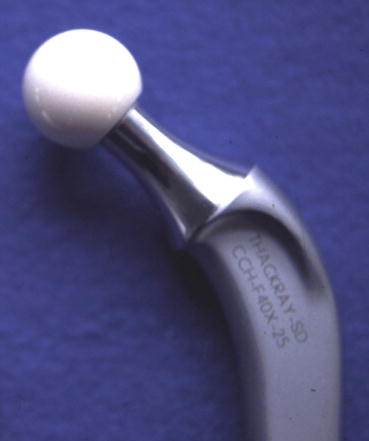, Paul D. Siney1 and Patricia A. Fleming1
(1)
The John Charnley Research Institute Wrightington Hospital, Wigan, Lancashire, UK
Studies of long term results of the Charnley LFA have repeatedly shown increasing incidence of cup migration with an increasing depth of cup penetration.
Factors affecting wear have been studied extensively and it was suggested that ceramics have a potential advantage over metal because of their geometric form and surface topography, together with enhanced hardness and scratch resistance.
A prospective clinical study was initiated in 1986 with 17 patients having 19 LFAs with a 22.225 mm alumina ceramic head on a Charnley femoral stem and a cross-linked polyethylene cup [1] (Fig. 39.1).


Fig. 39.1
Assembled prosthesis showing an alumina ceramic femoral head on a Charnley femoral component. 1986. The neck of the femoral component having a parallel section and an interposed polyethylene sleeve between the neck and the ceramic head
Their mean age at surgery was 53.2 years (range, 27–80). The cups were made of a chemically cross-linked polyethylene manufactured using injection moulding in order to reduce cost and wastage of the material.
Stay updated, free articles. Join our Telegram channel

Full access? Get Clinical Tree








